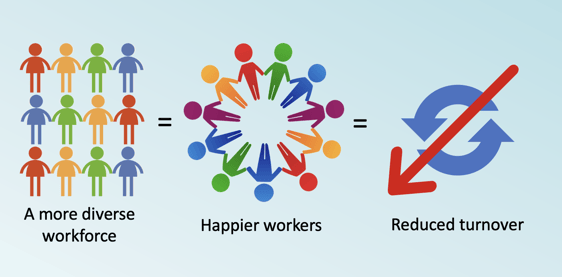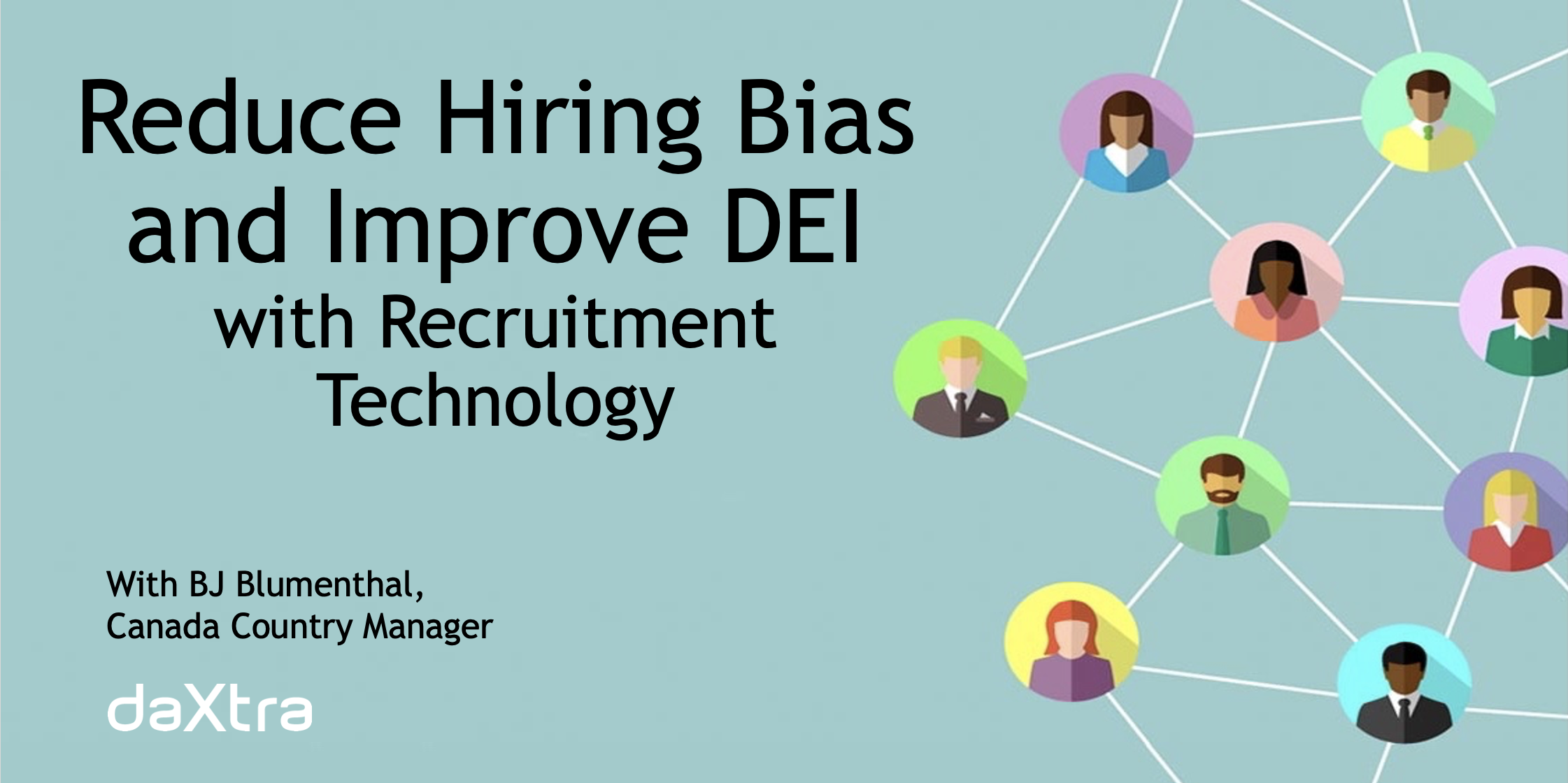Recruitment is a critical part of any company's talent acquisition strategy, as well as an important opportunity to improve diversity, equity, and inclusion (DEI). The most effective way to improve DEI at your organization is by reducing bias in hiring. But how do you do that?
In this webinar, hosted by the Association of Canadian Search, Employment & Staffing Services, (ACSESS), BJ Blumenthal, Canada Country Manager at Daxtra Technologies, walks us through what hiring bias is and the benefits of hiring diverse talent.
He also discusses what organizations can do to improve DEI hiring practices through the use of recruitment technology. The strategy involves reducing bias from the start of the hiring process through onboarding new hires into their roles within your company.
What is unconscious bias?
Hiring bias can be an ongoing problem even with training in place. Part of that problem involves unconscious bias which is inherent in all of us. These are biases that are unrealized and unintentional.
Some of the types of unconscious bias are:
- Perception bias
- Confirmation bias
- Affinity bias
- Halo or horns effect
- Conformity bias
Perception bias involves assumptions made by the recruiter. It is their perception of a candidate vs who the candidate is in reality. It is the tendency to form simplistic stereotypes and assumptions about certain groups of people.
Confirmation bias means favoring information you already believe to be true. It is basing your judgment on your belief rather than facts.
Affinity bias has to do with favoring someone because we find them similar to ourselves. Age, gender, similar educational background or life experiences may cause us to favor one candidate over the next.
Halo or horns effect comes about when we wholly judge a candidate on the impression they give us based on their appearance. Good or bad, it is our impression vs reality.
Conformity bias is the tendency to follow others' judgments to feel a part of the group. We may conform to others' decisions just to agree with them and make a hire easier.
How does hiring bias affect recruitment?
Because of the various hiring biases, it can be hard for businesses to find diverse candidates for open positions. It greatly limits candidate selection and eliminates people for the wrong reasons.
Unconscious bias enables hiring for the wrong reasons. Overlooking qualifications like specific skills and other important factors can come into play when implicit bias is present.
Hiring a person for the wrong reasons also leads to higher turnover rates. If someone is not fit for the job, they are likely unhappy and will want to find another job.
Benefits of hiring a diverse workforce
Some of the most valuable benefits of an inclusive and diverse workforce are:
- Workers with the best skill sets
- Reduction in staff turnover
- Better compliance with government-imposed or company diversity policies
- Increased productivity
- Increased company profits
When you source job candidates using parsing and search tools that hone in on skills above all else, you get the candidates with the best skill sets. Who doesn’t want highly-skilled workers? By matching skill to skill, you also arrive at candidates who are the best fit for the job. And with workers who find a good fit, you also have happier workers and a reduction in turnover.
A more diverse workforce also keeps you in compliance with internal diversity incentives, and in some cases, with government-imposed policies having to do with DEI.
As mentioned, satisfied workers stay at the job longer and are also more creative and productive. Increased productivity also results in increased company profits.
How do you eliminate unconscious bias in hiring, using technology?
Humans are naturally subjective. We are influenced by personal feelings, tastes and opinions. We make subjective judgments and decisions. Machines and computer technology software do not. Technology leaves the human perspective of subjectivity behind and bases decisions on objective reasoning. The value of objectivity is that you don’t have other influential factors and therefore you arrive at unbiased decisions.
Automation
Automation behind recruitment software ensures that when sourcing candidates, human biases are left out of the equation. This essentially eliminates bias at this initial stage of the recruitment process, giving a leg-up to DEI efforts at the onset.
The solutions behind objective recruitment automation are resume parsing and automated data loading. A resume parser helps identify skills and loads data into the system void of human-based decisions.
The parsing and loading functions of Daxtra Capture help to ensure that all incoming applicants are automatically loaded or updated in your database with rich, consistent data including, comprehensive skilling using your own taxonomy.
This solution calculates the skills’ proficiencies not by looking at how many times a skill is mentioned but by the recency, context and length of time the skill is used throughout the candidates’ career.
Daxtra Capture also tracks the incoming candidates against the jobs for which they have applied, the source from where they came from and consultant ownership. It monitors network or cloud folders to automate the loading of resumes which allows recruiters time to focus on finding and communicating with suitable candidates rather than doing administrative related work.
This technology will also save an anonymized copy of the resume for quick sharing with the hiring manager or external client.
Reducing bias using talent search technology
Using talent search solutions when sourcing candidates over job boards and the local database greatly reduces unconscious bias. The technology simply focuses on skills and experience and then ranks objectively.
Solutions like Daxtra Search Nexus search multiple sources simultaneously, with the exact same query, giving the advantage of never leaving your system to conduct multiple searches at one time.
The results are not arrived at through a typical ‘keyword hit’ search. The system learns from your database and suggests terms based on it. Users can also define keyword value types such as skill, job title and qualification to refine the context in which the keywords entered are searched.
To ensure consistency, users can use the same query to search across multiple platforms such as your local database, external job boards and social media platforms. This ensures that the queries entered for your local database are the same for external sources.
Users can also easily set up ‘Watchdogs’ which automatically run saved searches and send the related results via email.
Candidate rankings are purely based on keyword matching, including recency, length of experience and context, all of which are quantifiable. Users can verify the proficiency or match for each keyword used in the query for every result.
To further mitigate bias, results can have personal and other information such as dates, employer names and education institute names removed from the search results and the candidate preview. This includes their resume and other metadata on their record or candidate profile within the RMS.
Bias-reducing technology developer components
Besides premium solution packages, there are developer components that function much in the same way parts of the premium solutions work. Daxtra Components reduce bias in searching and matching talent and loading candidate data, but are licensed building blocks where the customer has full control of how the technology is deployed.
Daxtra’s suite of component technologies and web services provide the building blocks for you to power innovative, market-leading recruitment solutions. You can parse candidate work history, education and skills proficiency based on context, recency and length of time; remove dates; remove personal information, remove employer name, remove education institute name and auto-match candidates to jobs with these unique and powerful tools.
Control over the information populated in the candidate records from the 150+ fields extracted from documents with Daxtra Parser.
- Search and Match Web Services uses semantic search to locate candidates in a database as well as match candidates to jobs
- Search and Aggregation Services – searches across supported external job boards and social media
- Data Services – facilitates the term expansion, including aliases, synonyms, common typos and variations of the term.
Conclusion
As humans, we’re all guilty of unconscious biases. Everyone holds unconscious beliefs about various social and identity groups. Implicit bias forms from the social stereotypes we create without being consciously aware and stems from one's tendency to organize social worlds by categorizing subjectively.
Technology has an advantage because it doesn’t do this. It objectively comes to conclusions based on the parameters given. The parameters in the case of recruiting revolve around skills and experience — to match talent to jobs and jobs to talent.
Along with objective clarity with which the technology sources talent, the value recruitment technology brings to a company is immense. Precious time is saved and there are fewer errors and quicker hires.
Implementing technology to automate and streamline recruitment workflows is a smart decision. It helps eliminate unconscious bias in your hiring decisions by identifying and prioritizing information. It’s a powerful tool for making your recruiting process more inclusive and equitable and helps your organization reduce bias and improve diversity, equity and inclusion in hiring.
Read more on Diversity and Inclusion by downloading the eBook: Playing Fair — Unconscious Bias in Recruitment



